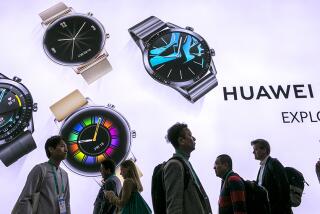If We ‘Circle the Wagons,’ We Shut U.S. Firms Out : Trade: Closing our markets to high-tech imports would hobble the healthy domestic sector with high-earning affiliates abroad.
Presidential contenders from both sides of the political spectrum are arguing that it’s time for the United States to circle the wagons and protect U.S. technological competitiveness by keeping foreign imports out of our market and keeping U.S. technology at home. Such isolationist notions are neither practical nor desirable. They only illustrate how far removed from the realities of global competition that U.S. political discourse has become.
Last month, an American firm and a Japanese firm announced a deal that dramatically underscores this point. Apple and Sharp have agreed to jointly develop and manufacture an emerging set of pocket-sized consumer products that will draw together features of the computer, cellular phone and electronic book. For Apple, the deal is attractive because of Sharp’s research and development capability, its manufacturing prowess and its strong presence in consumer electronics--a new and lucrative market for Apple. For Sharp, the attraction is Apple’s innovative software and a chance to get a leg up on Japanese competitors in developing user-friendly multimedia products.
The deal is just a small piece of a much larger trend that has proceeded apace for more than a decade. Driven by technological imperatives (pooling risk, exploiting technological synergies and entering new markets), major corporations such as Apple have developed global strategies that have resulted in an increasingly complicated network of interlocking technology, investment and production relationships.
Belying the premises of technological nationalism, such a system of complex interdependence does not lend itself to easy distinctions between friend and foe. Today, a rising portion of foreign trade--more than 50% by some estimates--is not international commerce in the traditional sense but consists of intra-company component and product transfers. In this world, closing U.S. markets to high-tech imports in many cases would directly undercut the competitiveness of American firms. Transfers of knowledge, investment and engineers within firms and across borders is essential to technological advancement and is at odds with the isolationist notion that technology is a physical asset that can be imprisoned at home.
The “circle the wagons” drive has been fueled by dependence on an outdated system of national trade statistics that ignores the rising importance of international investment flows and underestimates the strength of American firms in world markets. Many have pointed, for instance, to the decline in the U.S. share of world exports as an indication of the declining ability of American firms to compete. Measures of U.S. exports capture, however, only cross-border trade and do not take into account the sales of American affiliates in markets such as Japan, nor do they include the sales of foreign firms operating in the United States. Yet these transactions are significantly larger than the combined value of U.S. exports and imports. In 1987, the sales of American affiliates abroad and foreign affiliates in the United States, $815 billion and $731 billion respectively, dwarfed U.S. exports and imports of $336 billion and $484 billion.
Ignoring such a significant portion of modern-day commerce renders our current system of trade statistics incapable of informing the public-policy debate on the critical trade and investment issues raised by the emerging international economic order. Such inadequacies are detailed in a recent report, “Behind the Numbers,” from the National Research Council, that concluded that American-owned business are competing much better than assumed. In particular, after adjusting the trade figures to take into account the overseas sales of American- and foreign-owned affiliates, the report found the U.S. deficit in goods and services to be $64 billion in 1987, or less than half of the reported $148-billion trade deficit that year.
Clearly, tough economic challenges now confront the United States, at home and abroad. A decade of heavy borrowing has left Americans insecure and the future of the General Agreement on Tariffs and Trade (GATT) negotiations has never been more important yet uncertain. But to turn inward would resolve nothing and cost a great deal. More than rhetoric and election-year posturing, the nation needs leaders who can grasp the realities of technological and economic interdependence. Perhaps then, sensible policies that resist isolationist tendencies and that promote economic growth at home and abroad will have a fighting chance.
More to Read
Inside the business of entertainment
The Wide Shot brings you news, analysis and insights on everything from streaming wars to production — and what it all means for the future.
You may occasionally receive promotional content from the Los Angeles Times.









